Key Takeaways
- 46% of marketers said that inbound marketing gave them a higher ROI, whilst 12% of them reported that outbound helped them.
- Inbound sales methodology is a customer-centric approach to selling where the focus is on creating a personalized and engaging experience for the prospect.
- Inbound sales is effective as it involves understanding their pain points and offering solutions that address their specific needs rather than pushing a generic pitch.
In today’s digital age, the business landscape has completely changed. And it has also affected the way we connect and sell to customers.
With it, inbound sales has emerged as a powerful strategy that allows businesses to engage potential customers in a more personalized and effective way.
Unlike traditional outbound sales strategies, which focus on directly pitching people for sales, inbound sales takes a customer-centric approach.
Did you know? According to Spotio, 46% of marketers said that inbound marketing gave them a higher ROI, whilst 12% of them reported that outbound helped them.
Gone are the days of old-school sales techniques, where pushing products and bombarding potential customers with generic pitches was the norm.
So, let’s delve into inbound sales and see how its transformative impact on sales processes can benefit your business.
- What is inbound sales?
- Inbound vs. outbound sales
- Inside sales vs. inbound sales
- How inbound sales is evolving?
- Role of the sales team in inbound sales plan
- 3 major challenges faced by the inbound sales team
- 7 Important inbound sales statistics
- What are the stages of the inbound sales process?
- 8 Benefits of implementing inbound sales
- 11 Inbound sales best practices you need to implement
- 10 Inbound sales KPIs to track
- 4 inbound sales mistakes to avoid at any cost!
- Salesmate for inbound sales
- Conclusion
What is inbound sales?
Inbound sales is a transformative approach that focuses on attracting, engaging, and delighting prospects through personalized interactions and valuable content, ultimately nurturing them into loyal customers.
Inbound sales professionals act as trusted advisors to prospects. In addition, this sales process tends to create a personalized buying experience for the prospects.
Inbound vs. outbound sales
Inbound and outbound sales are two varied tactics of selling. And these terms are often misunderstood. So, here’s a clear difference between both concepts.
| Inbound Sales | Outbound Sales |
| Focuses on attracting and engaging potential customers | Proactively reaches out to prospects |
| Utilizes content marketing and lead generation strategies | Relies on cold calling and direct outreach |
| Aims to provide value and solve customer problems | Emphasizes product features and benefits |
| Builds relationships and fosters trust with prospects | Often involves one-time transactions |
| Nurtures leads through the buyer’s journey | Targets a wide audience, including those not actively seeking a solution |
Now that you’re aware of the concepts, you might come to thinking which one would be the best fit for your business.
This is a common tug-of-war between business leaders. So, to make the decision-making process easier, here are the pros and cons of both inbound and outbound sales.
| Inbound sales | Outbound sales | |
| Pros | • Builds trust and credibility with prospects • Targets a more qualified audience actively seeking solutions • Nurtures leads through the buyer’s journey • Focuses on building long-term customer relationships | • Allows for immediate, proactive outreach • Can reach a wider audience, including those not actively seeking a solution • Offers more control over the sales process and messaging • Can generate quicker results and faster conversions |
| Cons | • Requires time and effort to generate inbound leads • Results may take time to materialize and impact revenue • Relies on organic visibility and inbound traffic • Depends on the quality and consistency of content creation | • Can be perceived as intrusive or interruptive by prospects • May face higher rejection rates and lower response rates • Can lead to a higher cost per lead or acquisition • May require extensive training for outbound sales teams |
If you’re still curious about both of these concepts and want to know more, check out our detailed blog: inbound sales vs. outbound sales.
Inside sales vs. inbound sales
Inside sales refers to a sales model where reps engage with prospects and customers remotely, typically using technology and communication tools instead of conducting in person meetings.
It enables sales teams to efficiently connect with a broader customer base, increase productivity, and leverage data-driven insights to drive sales growth.
And the process of inside sales is quite different compared to other sales processes. Look at the below diagram to learn more:

When it comes to inbound sales, it’s quite different. While inside sales focuses on engaging with prospects and customers remotely, inbound focuses on attracting and engaging potential customers.
To better understand how inbound sales is different from inside sales, see the below image that explains their methodology:
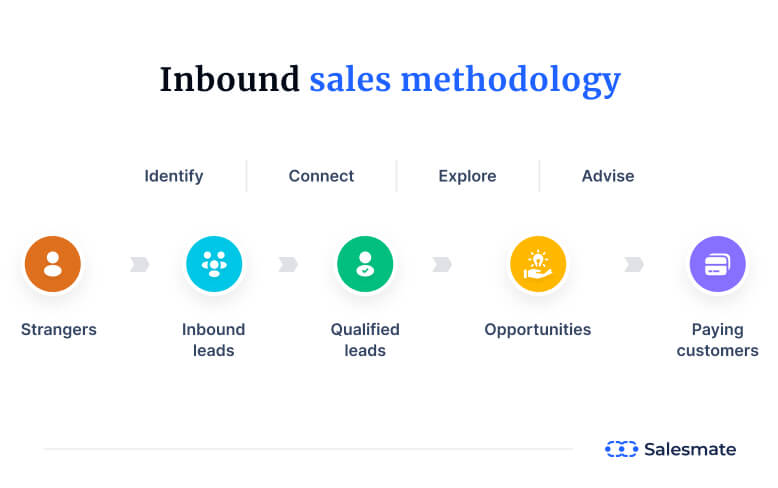
Also, inbound sales and inside sales are distinct concepts, they are not mutually exclusive, and businesses can often leverage both approaches to enhance their sales strategies and achieve better results.
How inbound sales is evolving?
As technology advances, buyer behaviors shift, and new trends emerge, the landscape of inbound sales has transformed.
And a major contribution to it is due to the evolution of the buyer’s journey. It’s something that directly affects the inbound selling practices.
The below image will give you a better understanding of the changing buyer’s journey and the role of marketing and sales:
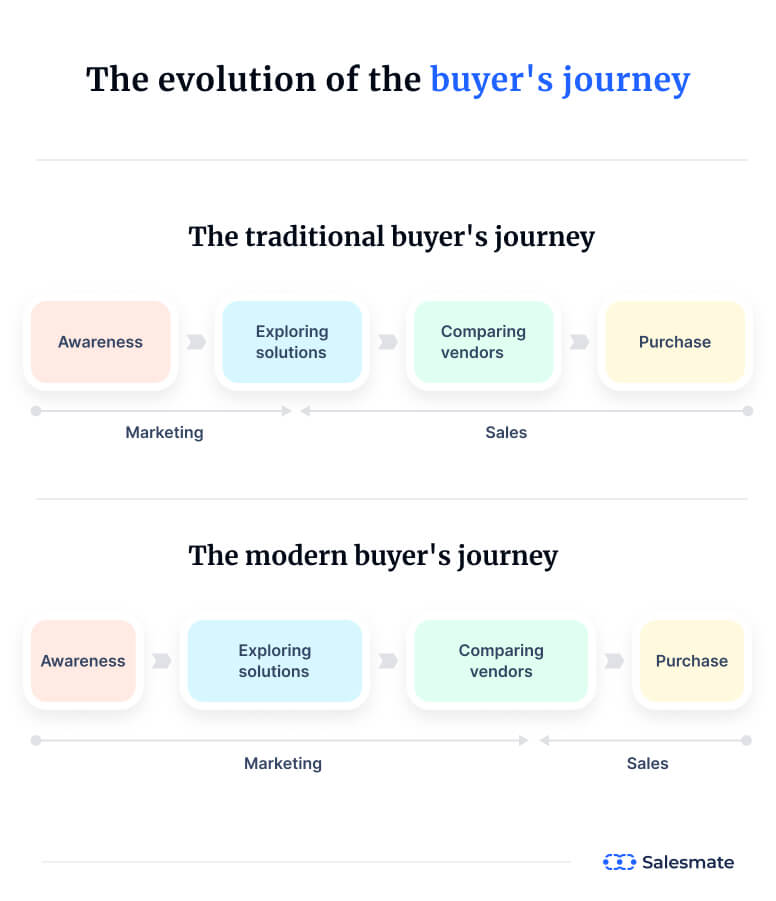
About 50-90% of the buyer’s journey is done before the customer gets a word with your sales reps.
So, by the time your prospects apply for a product demo, he is well aware of your business and its values.
Also, with the internet at their fingertips, consumers can freely research and compare products.
Plus, they have access to the review site as social proof, enabling them to make better purchasing decisions.
These are some significant shifts in your buyer’s persona, and sales managers must consider these insights before planning any sales strategy.
Customers want their needs fulfilled quickly, and inbound sales methodology fits right in the current scenario.
Here are five situations where buyers prefer interacting with sales representatives, as per Forrester:

Your inbound sales reps are required to show their sales skills more at the bottom of the sales funnel to hit their stress points and show them the value of the proposition.

Keep track of your prospects throughout the buyer's journey!
Salesmate lets you keep a bird's eye view of the entire sales cycle and easily identify leads that drive revenue.
Explore Sales PipelineRole of the sales team in inbound sales plan
Within an inbound sales plan, the sales team plays a crucial role in driving success. Let’s explore the key positions within the team and their respective responsibilities.
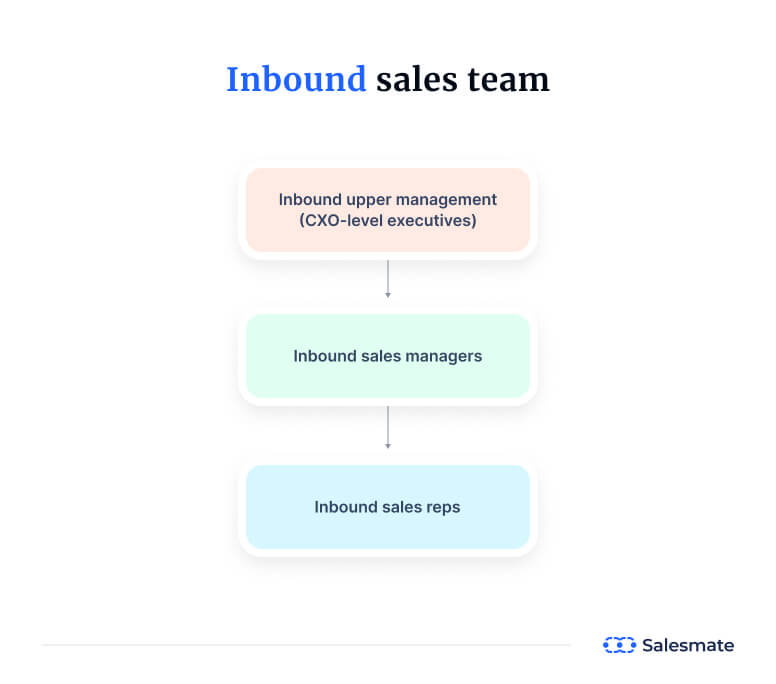
Inbound sales reps: They are the driving force behind your sales process. They directly handle prospects, answering inquiries, engaging with them, and providing tailored solutions.
Inbound sales managers: Inbound sales managers oversee the entire team, ensuring maximum deals. They monitor sales rep performance, analyze metrics, forecast sales, and develop strategies.
CXO-level executives: Senior managers and CEOs oversee the team’s progress. They track quarterly results, set business goals, and drive long-term growth.
3 major challenges faced by the inbound sales team
Sales teams encounter significant challenges that impact their effectiveness. Let’s explore them briefly:
1. Losing out on essential leads
A major challenge is failing to convert high-value leads to paying customers due to a lack of lead prioritization.
Research shows that 83% of businesses without proper lead prioritization experience below-average conversion rates. Implementing a robust lead qualification system helps identify and convert valuable opportunities.
2. Unable to identify the pain points
Understanding buyer personas is crucial, as it allows sales teams to connect with potential customers effectively.
Failing to identify and evaluate customer pain points makes it challenging to tailor sales approaches.
However, by gaining deep insights into customer needs, sales reps can offer solutions that resonate with their target audience.
3. Handling too many inbound inquiries
Inbound sales channels may experience overwhelming volumes of inquiries, posing challenges for efficient handling.
Without proper processes, valuable leads can be lost in the chaos. Therefore, establishing streamlined systems and timely responses is vital to manage the influx effectively.
7 Important inbound sales statistics
See how the inbound sales process can be a boon to your business. Here are some statistics highlighting the impact of inbound sales that you wish to achieve.
- 77% of B2B buyers reported that they tend to speak to sales reps after their research.
- 62% of salespeople who do not use inbound social selling miss their quotas.
- 75% of B2B clients rely on social media to help them with their purchasing decisions.
- IBM increased its sales by 400% thanks to its inbound social selling program.
- 84% of CEOs & VPs of a company take the help of social media before they make any purchasing decisions.
- 55% of customers use social media networks to conduct their research.
- 64% of sales teams reach their quotas using inbound social selling, whereas 49% of those who don’t use it still struggle to meet their quotas.
What are the stages of the inbound sales process?
In the inbound sales process, your buyer goes through three stages (awareness, consideration, and decision). Simultaneously, sales reps work on four significant actions to close the deal.

Let’s discuss the actions your inbound salespeople need to perform to get the deal in their account. Plus, how these actions relate to the inbound buyer’s journey stages.
1. Identify
To begin, start with understanding your potential customers better. Next, find out who would be interested in your product or service.
To do this, do thorough market research, oversee social media, and build user personas.
Afterward, understand your target audience’s demographics, pain points, and interests to build a great ideal customer profile.
By doing this, you can easily identify and ensure that the prospects you’re going after are interested in what you offer.
2. Connect
Once you’re done creating your ideal customer profiles to identify your ideal customers, start reaching out to them and establish an initial conversation ground.
During this process, you can reach out to them via multiple channels, such as email, text, social media, and calling. And to ensure that they convert, you can discover their unique needs and challenges and make the communication more personalized.
However, to make things more personalized, you need to define your user personas as close to perfection as possible.
Because this will help identify the company’s actual decision-makers and whom you’re trying to sell to.
3. Explore
During the exploration part of the process, sales teams engage in conversation with prospects to better understand the problem they’re facing and what solution they are looking for.
During this process, you can gather valuable information about their business, financial capability, and industry and tailor your solutions accordingly.
4. Advise
In the advise phase, sales reps need to provide solutions to the prospect’s problems based on understanding their desires discussed at the consideration stage.
Sales reps must come up with the right advice and highlight how their product is best suited to overcome the challenges or meet their goal.
Traditional sales pitches won’t work here; develop practical solutions.

Engage Seamlessly through Omnichannel Communication!
Utilize Salesmate's Built-In Calling, Texting, and Emailing features to easily connect and provide the right solution.
Start your free trial8 Benefits of implementing inbound sales
Inbound sales strategy, a data-driven approach, offers numerous advantages for businesses seeking to optimize their sales processes. Let’s explore the key benefits:
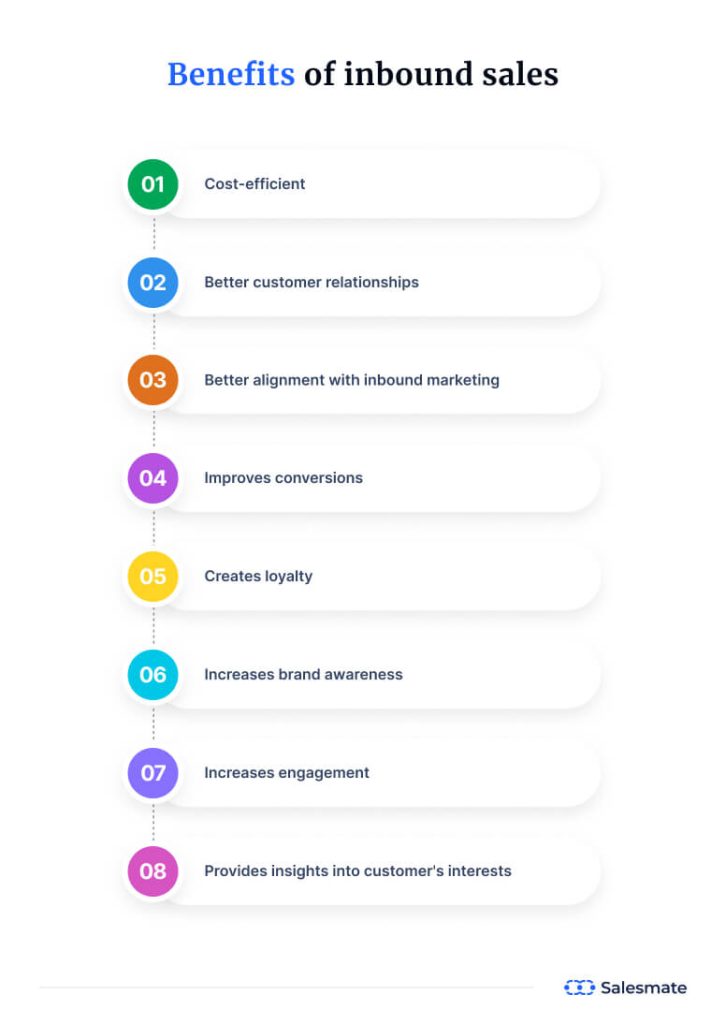
1. Cost-efficient
The inbound sales process proves to be cost-effective compared to traditional methods.
By investing in organic marketing tactics like SEO and content creation, businesses attract high-quality leads, eliminating the need to spend money on purchasing low-quality leads.
2. Improved conversions
With a focus on attracting genuinely interested prospects, inbound selling makes it easier to convert them into customers. The targeted approach results in higher conversion rates compared to traditional sales techniques.
3. Creates loyalty
Inbound sales places customer needs at the forefront, fostering loyalty. Businesses build strong customer relationships by providing valuable assistance and guidance, earning trust and long-term loyalty.
4. Better customer relationships
Meeting customer expectations and helping them achieve their goals fosters better relationships. In addition, by offering valuable feedback and guidance, businesses strengthen their connection with customers, facilitating informed decision-making.
5. Better alignment with inbound marketing
Inbound sales and marketing teams work hand in hand, resulting in a shorter sales cycle. In addition, businesses streamline the sales process by focusing on qualified leads driven by marketing efforts.
6. Increased brand awareness
Publishing valuable content on social media and other channels as part of inbound sales increases brand visibility. By attracting the right prospects, businesses boost brand awareness and establish themselves as industry leaders.
7. Increases engagement
Inbound sales practices encourage customer interaction through live chats, email exchanges, demos, or calls. Sales reps proactively engage with prospects, understanding their desires, goals, and pain points, leading to increased customer engagement.
8. Provides insights into customer’s interests
Inbound sales leverage a data-driven approach, enabling businesses to target customers based on their specific needs and desires. By tailoring resources and solutions, businesses provide personalized experiences, satisfying customer interests effectively.
Implementing inbound sales empowers businesses to achieve optimal results, driving conversions, loyalty, and brand awareness while building meaningful customer relationships.
11 Inbound sales best practices you need to implement
The inbound sales process is all about how you can help your prospects to overcome their business challenges. Let’s discuss some common inbound sales tactics to practice:
1. Create targeted content
Brands that target through personalized content will boost inbound sales opportunities.
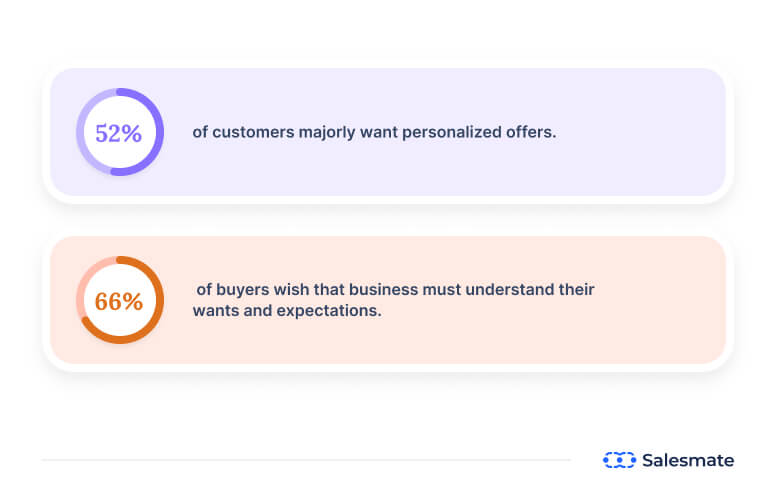
Your sales team should determine the customer’s search intent, the type of content they are engaging, your competitor’s content strategy, etc., to build the right sales collateral to target at every stage.
2. Score your inbound leads
To discover the likelihood of a generated lead, you must score them.
Scoring inbound leads is crucial as it ensures that only qualified leads enter your sales pipeline from the inbound marketing efforts.
3. A-B-H (always be helping)
Inbound sales is driven when your sales reps harbor the approach of A-B-H (Always Be Helping) over A-B-C (Always Be Closing).
The inbound sales and marketing team is determined to provide value to their prospects throughout their buyer’s journey to make them understand how their product/services benefit them. And sales conversion is a by-product of such efforts.
Sales representatives that play a trusted advisor or consultant role giving the right insights and helping their prospects achieve their business goals tend to close more deals.
4. Focus on the buyer’s preferences
Conversion seems more accessible when you prioritize your prospect’s desires and preferences and convince them that all the actions favor their demands.
So, if a prospect is at the awareness stage, don’t push them to convert; discover their aspirations and serve what they’re seeking.
5. Personalize the buying experience
A personalized buyer experience will establish your brand credibility and boost customer engagement.
About 80 % of buyers make a purchase when a better-personalized customer experience is proposed.
6. Be a good listener
Be a good listener to your prospects, as it will help you understand your buyer’s desires, concerns, or anything that will help you to offer them a better customer experience.
Knowing your customer’s stress points allows you to take them in more confidence to be a problem solver. It also helps you to decide whether this audience is the right fit for your business to target.
7. Build connections with context
Your reps must be smart enough to understand the proper context to initiate a conversation that hopefully turns into a sales opportunity.
Suppose an inbound lead is at the awareness stage, coming to your site to learn more about your product (let’s say; you offer a CRM tool). Then, an explainer guide or video might be the right resource.
Remember, not all leads generated through inbound efforts come to you with the same perspective, so your reps must communicate based on their desires associated with your brands.
8. Value proposition over the sales pitch
Inbound sales strategy is impactful as it focuses on solving customers’ problems over pitching for sales.
To win with inbound sales, your sales team must explore your prospect’s goals, challenges, strategy, timeframe, and budget. Then, based on these, try to offer the value proposition that adds to their growth.
In this manner, this value proposition will build trust and convert them your paying customers.
9. Build strong rapport
With a strong brand rapport, customers will get easily convinced that your product/services can help them accomplish their business goals.
Building rapport in inbound sales means asking meaningful questions to unleash a path to overcome their major stress points and meet their goals.
See the image below to learn how to build a strong brand rapport.
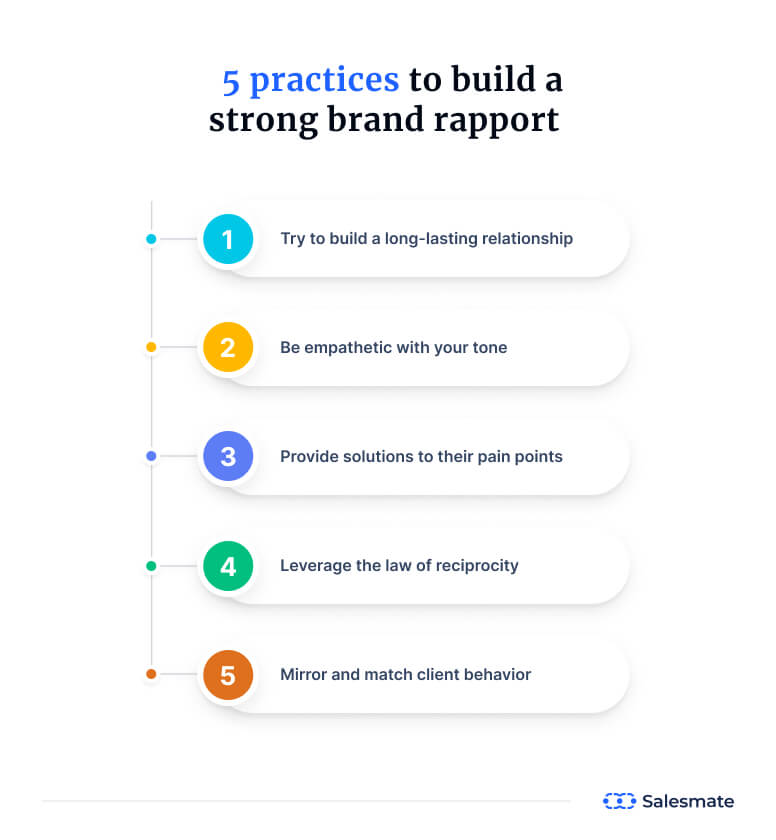
10. Being available 24/7 with a chatbot
Ensure that your prospects get the answer to their queries anytime, develop a chatbot system on your site and either create custom chat journeys or provide live chat.
11. Responding to inquiry emails
You can set up email automation to respond instantly to leads as they move across the pipeline. And even save time by utilizing pre-made email templates to answer common queries.

Boost Your Email Engagement Like Crazy!
Engage better, track success and drive results faster with Salesmate’s Email Automation.
Start your free trial10 Inbound sales KPIs to track
Different KPIs are helping each level of an inbound sales team (reps, managers, and top-level bodies) to meet their roles and responsibilities in a better way.
Let’s dive deep into which inbound sales KPIs to focus on and by whom.
- Inbound sales representatives’ KPIs
Some KPIs are helpful for your inbound salespeople to analyze their daily operation and their efficiency. It lets them know whether the efforts are working or not!
Let’s know about them below.
1. Average response time
About 82% of customers expect responses to their queries within 10 minutes. So your average response time should be very optimal.
The average time taken to respond to an inbound lead by a sales rep is the average response time.
It can be measured by dividing the total time taken to respond within a specific period by the number of responses made.
About 50% of customers go to those vendors who respond first. Therefore, your salesperson must be the quickest among your competitors with their average response time.
The support of a sales productivity tool can help you improve your average response time.
2. Average follow-up
Average follow-up is a sales metric that talks about the average no. of customer engagement activities attempted by an inbound sales representative.
It can be calculated using the formula below.
Average follow-up per lead = Total number of follow-up attempts/Total number of leads.
3. No. of meetings booked
Inbound marketing efforts would only be worthwhile if your reps are smart enough to convert them.
This KPI opens about your sales reps’ efficiency in moving the prospects to the next phase of the sales pipeline.
Find the roadblocks if your reps fail to advance the conversation into a one-on-one meeting. Inadequate training, insufficient sales collateral, inefficient process, or unavailability of rights might be some significant roadblocks to consider here.
4. No. of offers sent
Once your salesperson achieves all the above KPIs on point, like the lowest response time, 100% follow-up graph, and converting every inquiry into meetings, one KPI is left to be apt on; no. of offers sent.
You will know about the work efficiency of your salesperson when you compare the ratio of the number of inbound queries handled (calls, meetings booked, and emails) to the number of offers sent.
- Inbound sales managers’ KPIs
These KPIs can express how well your current activities are doing or if there is a significant space to upgrade. Check out some of the tactical KPIs below.
5. Average call duration
The average call duration KPI can reveal your sales reps’ knack for handing leads on call. It also reveals how long your reps talked with an inbound lead on average.
A long call duration with no conversation could be a concern to resolve. This KPI is also helpful for finding out about your underperforming salesperson.
You can calculate the average call duration with the formula below.
Average call duration = (Total time on calls)/(No. of accepted inbound calls)
Record all the inbound call handles and listen to find the loopholes to improve.
6. Avg. Inbound conversion rate
This KPI tells you how many inbound inquiries have been turned into your paying customers in a specified timeframe.
You can calculate the average conversion rate using the formula below.
Average conversion rate = (Total no. of conversions/Total no. of leads) x 100
It is an excellent indicator of your sales team’s efficiency and process.
7. Inbound pipeline velocity
This KPI helps you understand the entire customer journey from the first point of contact until it converts.
It lets you discover the touch points where the prospects drop off the engagement with your salesperson.
You can calculate the pipeline velocity with the help of the below.
Pipeline velocity= (No. of opportunities x win rate x average deal value)/ current sales cycle
It is a powerful KPI to identify touchpoints where you’re going wrong and to fix them to manage a seamless pipeline to meet your sales quotas.
- KPIs to track for top level
To know the overall performance of the company/business, consider these KPIs.
8. Close ratio
A close ratio is an inbound sales metric. It estimates the number of prospects your reps engaged to the number of deals closed.
Check out the formula below to calculate your close ratio:
Close ratio= Number of closed deals/Total lead opportunities
It helps to analyze the potential of each rep in your sales team.
9. Inbound sales growth
It measures your sales reps’ capability to increase revenue in a specified period (quarterly, annually, etc.). This KPI is a direct indicator of the revenue or profits made.
Use the formula below to calculate sales growth:
Sales growth = [(Sales in the current period – sales in the previous period)/ sales in the previous period]x 100
You get the exact value of your sales growth; you need net sales figures for the two financial periods.
10. New business revenue
This KPI lets you track how much revenue is made from first-time buyers. New business revenue is measured monthly against a target percentage.
For instance, you must make 20% of the revenue from your first buyers.
Your inbound sales KPIs are critical because they let you differentiate why a deal gets close, and others don’t.
For example, sales reports can help your inbound sales managers identify roadblocks and help them to make better decisions that boost sales success.

Make data-driven decisions to get better results!
Generate detailed reports to derive actionable insights and improve decision making.
Explore Sales Reports4 inbound sales mistakes to avoid at any cost!
Identify your pain points and manage your leads, to ensure that your sales team makes no mistakes.
1. Prioritizing the wrong leads
Proper lead prioritization is essential for sales professionals to maximize their efficiency.
By focusing on leads who show genuine interest, engage with your brand, and exhibit relevant online behavior, your team can allocate their time and effort more effectively.
Analyzing onsite behavior, social media engagement, and email campaign reports helps pinpoint customer interests accurately.
2. Having incomplete information
Equipping your sales team with comprehensive information about your ideal customer profile and persona is crucial.
Conversations may become repetitive or disjointed without a clear understanding of a lead’s nurturing stage or position in the pipeline.
Implementing reliable customer relationship management (CRM) software ensures all relevant details are easily accessible, preventing communication gaps.
3. Absence of a handoff process
A well-defined handoff process ensures smooth transitions between sales team members. Without it, repeated information sharing, confusion, and missed opportunities can occur.
Establishing a shared team inbox or collaboration platform enables real-time updates and enhances productivity by providing visibility into the activities required to close deals.
4. Taking too long to respond
Timeliness is critical in sales, as delayed responses can lead to missed opportunities. By promptly addressing inbound leads, your team increases the chances of converting prospects into customers.
Automation tools can alleviate some pressure by enabling the use of canned responses for specific actions, ensuring swift and consistent communication.
By avoiding these common mistakes and implementing effective strategies, your sales team can optimize their performance, increase conversion rates, and seize valuable opportunities.
Salesmate for inbound sales
Salesmate is an all-in-one customer relationship management (CRM) platform designed to empower your sales team with the tools and capabilities needed to thrive.
With its robust features and intuitive interface, Salesmate helps businesses effectively manage their inbound sales processes and maximize conversions.
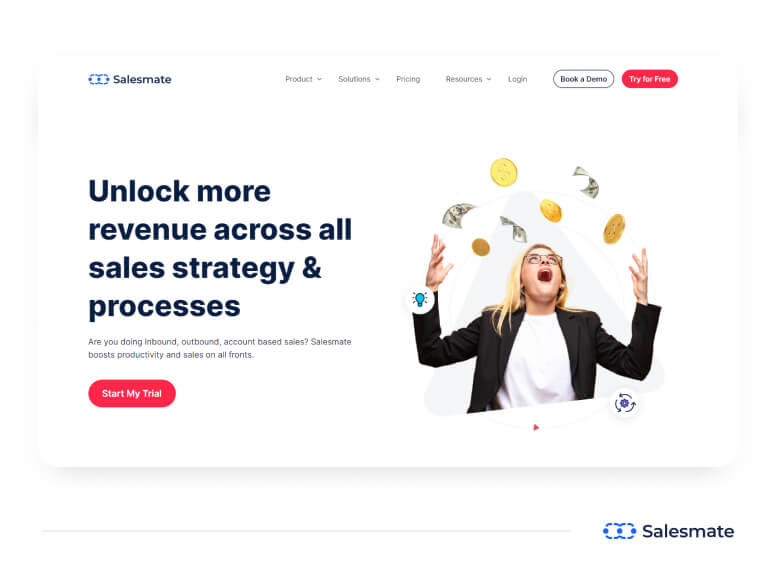
- The contact management feature saves up to 37% of your valuable time as you can perform bulk activities.
- Set up data entry automation to save reps’ time and toss it to sales conversion.
- Chat Journeys and Live Chat help your inbound sales professionals generate leads and engage with web visitors.
- Connect with your leads instantly with our Built-it Calling feature that has access to 80+ countries worldwide.
- Use our call forwarding and transferring feature to handle multiple inbound calls smartly.
- Reply with a canned response instantly and never leave a chance to shine.
- Sales activity tracking lets you track your sales reps’ performance.
- Analyze your inbound sales progress and roadblocks through our advanced Sales Reports.
Conclusion
Throughout this blog, we’ve explored the essence of inbound sales, its benefits, key strategies, and the challenges it entails.
Inbound sales allow businesses to prioritize their efforts and focus on the most promising opportunities.
By identifying and engaging with qualified leads, sales teams can optimize their time, increase conversion rates, and achieve higher overall sales productivity.
In conclusion, inbound sales is a powerful methodology that aligns sales and marketing efforts, nurtures meaningful connections, and drives sustainable business growth.
What are inbound leads?
Inbound leads are potential customers that contact you due to your inbound marketing practices. To attract these high-quality leads, you need to invest good time in building strategy and setting powerful campaigns.
What do inbound sales reps do?
Inbound sales reps respond and handle all the inbound leads. They nurture them to close the deal. Phone calls, live chat, emails, and text messaging are common ways to communicate with inbound leads.
Is inbound or outbound sales better?
A combination of both sales processes (inbound and outbound) is considered effective for businesses. Also, for a short-term goal, outbound might be a better option to go with but for a long-term solution, inbound sales is the best option.
Why should you build an inbound sales process?
Inbound sales is empowered due to the limitless success of buyers’ online activities that help in interest-based targeting. A proper process that clearly defines the inbound marketing and sales objectives will help you boost the opportunity of closing deals.
You may also enjoy these
50+ best marketing and sales tools to look in 2023
Businesses, be it small or big, wish to grow. If they’ve achieved a 10% growth in the current year, they would...
33 Min read15 Clever ways to increase manufacturing sales faster in 2023!
Searching for ways to amplify sales in...
11 Min read21 AI sales tools to boost sales in 2023 [Reviewed & tested]
AI has achieved great leaps forward in making marketing and sales operations easier and...
19 Min readANUM sales qualification: All you need to know!
According to a study, 22% of sales reps reported sales qualification as the most challenging part of their sales...
10 Min readMQL Vs. SQL Vs. PQL: What’s the difference?
21% of salespeople and marketers are unsatisfied with their current lead qualification...
11 Min readMake sales sexy again 😉
- Save at least 50% on subscriptions and integrations.
- Save 30% more time for your sales team.
- Choose a CRM trusted by 5000+ businesses.




Sonali Negi
Sonali is a writer born out of her utmost passion for writing. She is working with a passionate team of content creators at Salesmate. She enjoys learning about new ideas in marketing and sales. She is an optimistic girl and endeavors to bring the best out of every situation. In her free time, she loves to introspect and observe people.